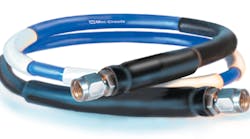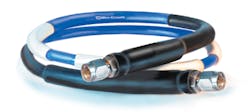Download this article in PDF format.
Coaxial cables are those often-overlooked components in a high-frequency systems, usually only noticed when they fail due to overworked or over-torqued connectors or over-flexed conductors. One line of coaxial cables built to last is the KBL series from Mini-Circuits, with high-quality plated conductors, rugged armor jacket, and durable 2.92-mm connectors. The combination of low-loss cables and connectors results in a line of fixed-length cables with instrument-grade performance from dc to 40 GHz.
The KBL coaxial cable assemblies (see figure) are available in stock lengths of 1.5, 2, and 4 ft., as well as 1- and 2-m and custom lengths. The RoHS-compliant cables use a solid silver-plated, copper-clad-steel center conductor and round silver-plated, copper outer conductor. The cables achieve excellent insulation between the conductors with polytetrafluoroethylene (PTFE) dielectric, and are fortified by means of stainless-steel spiral armor with a stainless-steel braid. The cables feature a protective shield and strain relief for long life and are terminated at both ends with stainless-steel 2.92-mm connectors. A blue PVC outer jacket protects the cables.
The KBL series of fixed-length coaxial cable assemblies, featuring rugged armor construction and stainless-steel 2.92-mm connectors, can handle dc to 40 GHz.
The connectors are designed to handle a large number of mating cycles with minimal performance degradation, and mate with K, 3.5-mm, and SMA connectors. The design and assembly of the coaxial cable assemblies results in reliable long-term performance, especially in test-and-measurement applications where connectors are attached and removed repeatedly to a test port or a device under test (DUT).
The cable assemblies exhibit low insertion loss and return loss (VSWR), with loss increasing as a function of increasing frequency. For example, for the shortest cable assembly, the 1.5-ft.-long KBL-1.5FT-LOW+, insertion loss is typically 0.49 dB from dc to 6 GHz, 0.85 dB from 6 to 18 GHz, 1.10 dB from 18 to 26.5 GHz, and 1.41 dB from 26.5 to 40 GHz. Return loss is typically 25 dB from dc to 6 GHz, 20 dB from 6 to 18 GHz, 18 dB from 18 to 26.5 GHz, and 17 dB from 26.5 to 40 GHz.
For the somewhat longer 1-m (about 3.28 ft.) KBL-1M-LOW+ cable assembly, insertion loss is typically 1.06 dB from dc to 6 GHz, 1.87 dB from 6 to 18 GHz, 2.35 dB from 18 to 26.5 GHz, and 3.05 dB from 26.5 to 40 GHz. Return loss is typically 25 dB from dc to 6 GHz, 20 dB from 6 to 18 GHz, 19 dB from 18 to 26.5 GHz, and 17 dB from 26.5 to 40 GHz. The table provides a quick comparison of loss performance for the cables from dc to 40 GHz.
The KBL coaxial cable assembles are designed for operating temperatures from ‒55 to +85ºC. All of the cables are rated for power-handling capabilities of 53 W at 2 GHz, 17 W at 18 GHz, 15 W at 26.5 GHz, and 11 W at 40 GHz. With their rugged armored construction, low-loss plated conductor materials, and stainless-steel connectors, these are coaxial cable assemblies that won’t be overlooked, especially because of their ability to deliver reliable electrical connections when needed through 40 GHz.
Mini-Circuits, P. O. Box 350166, Brooklyn, NY 11235-003; (718) 934-4500, FAX: (718) 332-4661.



